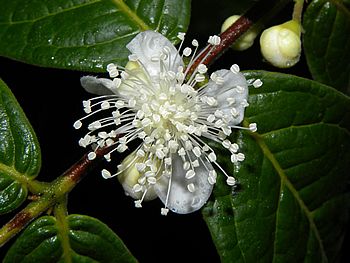The Araza Boi Fruit (Eugenia stipitata) is a shrubby plant native to the Amazon region, still little known in worldwide, but with tasty fruits and high productivity. From the same family as the jabuticaba, guava and pitanga, the Araza Boi is highly branched and leafy. Its leaves are simple, opposite, petiolate, elliptical to lanceolate in shape, acuminate, and dark green in color.
The inflorescences are of the thyrsus type (raceme of cymes) and display delicate white, hermaphroditic flowers, with four petals each and many long stamens. Following pollination, the fruits develop, which are of the berry type, globular, large, juicy, fragrant, and acidic, with a thin and yellow skin when ripe. Each fruit can weigh from 200 to 400 grams (7 to 14 ounces) and contain 4 to 12 seeds.
The fruits of the Araza Boi have a delightful aroma and are soft, with a rich pulp. However, due to the high acidity of the fruit, it is not much consumed in natura. Despite this, it yields delicious vitamins and juices, prepared with water, milk, or yogurt, and is highly sought after for making jams, compotes, ice creams, mousses, popsicles, and desserts in general. Being very perishable, it is difficult to transport or store the fresh fruit, thus becoming a rarity in sales points. Meanwhile, the frozen pulp is a much more accessible product and an increasing export item.

The Araza Boi is a perfect tropical shrub for small or large home orchards. Low maintenance, the Araza Boi produces about 4 to 5 times a year under favorable conditions. It is rugged and requires no special management, but it is necessary to collect fallen fruits to prevent the spread and development of fruit flies, a pest to which it is highly susceptible. Due to its small size, it can also be planted in pots and planters, fitting into small urban spaces.
It should be grown in full sun, in preferably fertile, deep, and well-drained soils, irrigated regularly in the first year of implementation or in case of drought. Although it bears fruit better under these conditions, the Araza Boi grows well in poor and acidic soils, provided there is no prolonged drought. It appreciates the humid tropical climate and does not tolerate frost or intense cold, below -3°C (26.6°F). Sensitive to rust and anthracnose.
It is easily multiplied by seeds, depulped and subjected to dormancy breaking with partial or total removal of the shell (tegument), which gives them greater uniformity and a better germination rate, shortening the emergence from 3 to 4 months to 50 days or less. The seeds should be sown fresh, as stored seeds have reduced germinative power and increased dormancy. It is very precocious and bears fruit soon after one to two years of planting. Irrigate the developing seedling and prevent weeds from growing and choking it.


